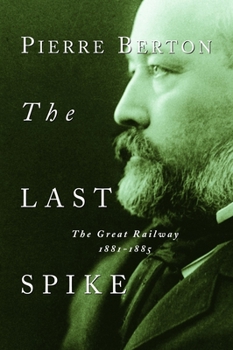The Last Spike: The Great Railway, 1881-1885
Select Format
Select Condition 
Book Overview
In the four years between 1881 and 1885, Canada was forged into one nation by the building of the Canadian Pacific Railway. The Last Spike reconstructs the incredible story of how some 2,000 miles of... This description may be from another edition of this product.
Format:Paperback
Language:English
ISBN:0385658419
ISBN13:9780385658416
Release Date:August 2001
Publisher:Anchor Canada
Length:496 Pages
Weight:1.20 lbs.
Dimensions:1.2" x 6.1" x 9.0"
Customer Reviews
1 rating
The Line that Joined a Nation
Published by Thriftbooks.com User , 19 years ago
"The Last Spike" chronicles the building of the Canadian Pacific Railway (CPR), 1881-1885, then the world's longest railway, extending a young Canada westward and consolidating its territories. Originally published in 1971 by the prolific Canadian historian, the late Pierre Berton, this is a well-researched account of a project now generally overlooked outside Canada. Amply endowed with facts, the book is nonetheless a fluent and gripping read, far removed from the dry and dusty history one might expect of such a topic. Laced with dramatic tension, it details the massive undertaking and paints memorable portraits of the principal characters involved, such as Prime Minister John A. MacDonald, financiers Donald A. Smith and George Stephen, and the inimitable William Cornelius Van Horne, an American-turned-Canadian, general manager of the enterprise. The author explains the political, economic, and nationalist reasons for building the CPR. The engineering challenges were colossal, the logistics mind-boggling. Harnessing the energies of a domestic, indigenous and multinational workforce the rails advanced -- sometimes fitfully, at other times with impressive, regimented speed. As the track moved west, new towns flourished and the vast prairie -- the grain heartland of modern Canada -- was opened up. The line brought prosperity and tourism to the once-mysterious fastness of the west and made present-day Vancouver possible. At 1,800 miles long (excluding the eastern network laid down earlier), the line was completed in half the time imposed by the government contract -- including the formidable 500-mile stretch through the Rockies and the Selkirks. Most of the time the venture was on the brink of failure, due to competition and the nervous response of foreign investors to slur campaigns in America and Britain. The necessary capital appeared just in time, thanks largely to the Canadian government's need to quell rebellion in the northwest -- one of the book's highlights and illustrative of the role played by luck in history. The hardcover edition contains a few maps, but more would have helped. The bibliography is extensive, the index adequate. If you are interested in railways, Canada's history, or have an affinity for large-scale works, this book will reward you.





